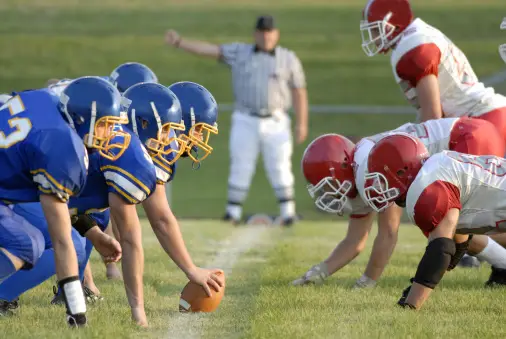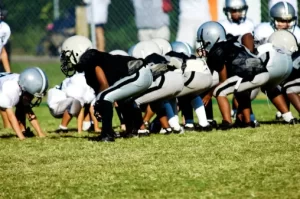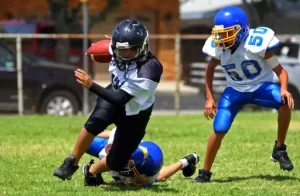A jamboree in football primarily pertains to the high school and youth level. A Jamboree serves as a unique and beneficial event in preparation for the upcoming season.
What is a Jamboree in Football? A Jamboree is essentially a scrimmage with multiple teams rather than just two. Consisting of multiple teams coming together, the jamboree allows teams to participate in simulated games against each other.
This enables young players to gain valuable experience and work on their skills in a condensed timeframe While also providing an efficient way to prepare for the regular season.
Contents
What Is a Jamboree in Football
A jamboree in football primarily takes place at the high school and youth level. It is an event where multiple high school football teams gather to play simulated games against each other. The main purpose of a jamboree is to offer these young teams ample practice and preparation in a short period of time before the regular season begins.
During a jamboree, each team will participate in a controlled scrimmage. Typically lasting around two hours. Four teams compete against one another on half fields. This setup allows teams to get a feel for their performance without the pressure of a full-fledged game.
The jamboree serves as a “dress rehearsal” for teams. Offering them the opportunity to test out their strategies, identify strengths and weaknesses, and make necessary adjustments before the start of the regular season. Since it occurs during the preseason, it helps coaches and players get a better understanding of their abilities and areas for improvement.
While jamborees do not follow the exact same rules as regular games, they strive to adhere to the guidelines laid out by the National Federation of State High School Associations (NFHS). This ensures the emphasis stays on learning and preparation, rather than winning or losing.
History of Football Jamborees
Origins
The term “jamboree” has its roots in the Scouting program. This is where it was first used to describe a large gathering or rally of scouts at the inaugural Boy Scout Jamboree in 1920. The term eventually found its way into football, as high school teams began hosting their own jamboree events. These events were designed as a way for multiple football teams to gather and play simulated games against one another over a short period. All while helping them prepare for the upcoming season.
Evolution of the Concept
Over the years, the football jamboree concept evolved to take on different formats and scopes, depending on state and regional preferences. In some cases, the original idea of a multiteam jamboree evolved to include related festivities, such as the crowning of a “jamboree queen” or the inclusion of carnival-like atmospheres. These events now serve not only as a means for football teams to practice and prepare for the season but also as an exciting signal to players, fans, and coaches that football season is about to begin.
Benefits of Football Jamborees
Jamborees build camaraderie and competitiveness among teams. They also offer important opportunities for players to acclimate to performing in front of crowds.
As an essential component of the preseason, a jamboree functions as a dress rehearsal that measures the performance of individual teams and individual players alike. By participating in these preseason events, teams are better equipped to finalize their rosters as they move forward into the regular season.
Football jamborees present high school and youth teams with a vital platform for honing their skills and building team dynamics. By engaging in these single-day events, players and coaches alike can assess their team’s strengths and weaknesses. While also allowing them to better prepare for the challenges that lie ahead in the regular season.
Sportsmanship
Football jamborees provide an opportunity for teams to foster sportsmanship among players. Since these are preseason scrimmages or exhibition games, participating teams can focus on building camaraderie and respect, both within their own teams and with their opponents. This helps players develop positive attitudes and behaviors that will aid them throughout the season.
Skill Development
Jamborees play a crucial role in skill development for football teams. These events allow players to apply what they’ve learned during practice in game-like situations. By participating in jamborees, players can work on their techniques and tactics, improving their skills before the official season starts. Additionally, coaches can use these games to identify areas where the team may need further training or adjustment.
Community Engagement
A football jamboree can help engage the local community and generate excitement for the upcoming season. Fans, families, and community members can come together for a day of fun, entertainment, and an early preview of the teams. As many high school football teams experience significant turnover each year, jamborees give new varsity starters a chance to perform in front of large crowds and acclimate to the high-pressure atmosphere of regular season games. In turn, community support can enhance the motivation and performance of the athletes.
Types of Jamborees
Youth Football Jamborees
Youth football jamborees are aimed at younger players. Where the focus is on skill development, teamwork, and fun. These events often incorporate skill-based drills, games, and scrimmages that help to enhance the players’ understanding of the game. Rules often slightly differ as they are adapted to cater to youth players, like using smaller field sizes and shorter playing time. Ultimately, the goal of youth football jamborees revolves around fostering a love for the sport and creating a positive, inclusive environment.
High School Football Jamborees
High school football jamborees serve as a preparatory event for the upcoming season. A key feature of these jamborees is the scrimmage format, where several teams participate in simulated games against one another. The purpose is to evaluate player performance, identify strengths and weaknesses, and provide an opportunity for players to gain valuable game experience. These scrimmages often have a more competitively charged atmosphere, as high school coaches are assessing their rosters and devising game strategies.
Jamboree Hosting
Organizing a Jamboree
Organizing a football jamboree involves bringing together multiple high school teams to participate in simulated games. These events help teams prepare for the upcoming season, acclimate players to perform in front of crowds, and finalize their rosters.
The first step in organizing a jamboree is selecting a suitable location, preferably a football field with adequate seating capacity and facilities for multiple teams.
Next, coordinate with coaches and athletic directors of participating teams to finalize the schedule and game format.
Keep in mind the following factors when organizing a jamboree:
- Considerations for player safety, including proper equipment and medical staff on site
- Scheduling to avoid conflicts with other commitments for participating teams
- A well-stocked concession stand to provide food and beverages for players and spectators
Requirements
There are certain requirements that must be met for hosting a successful football jamboree. These include:
- Adequate facilities:
- Football field(s) in good condition
- Restrooms and locker rooms
- Parking space for attendees
- Staffing and Volunteers:
- Referees and officials for each game
- Scorekeepers and timekeepers
- Security personnel for crowd control
- Volunteers for setup, cleanup, and assistance during the event
- Permits and Insurance:
- Necessary permits from local authorities for the event
- Liability insurance to cover any accidents or injuries that may occur
- Communication:
- Informing participating teams and spectators of the schedule and rules
- Advertising the event through local media and online platforms
Sponsorship
Securing sponsorship from local businesses or organizations can help offset the costs associated with hosting a jamboree. While also providing additional resources to enhance the experience for participants and spectators. Approach potential sponsors with a proposal that outlines the benefits of partnering with your event. Such as increased exposure and brand recognition within the community. Some examples of sponsorship opportunities include:
- Donating items for raffles or giveaways
- Providing financial support for field rentals, officials, or equipment
- Offering discounted or donated services, such as printing or catering
- Displaying banners or promotional materials at the event
Famous Football Jamborees
The concept of football jamborees is most prevalent at the high school level, where multiple teams come together for a day of practice and competition before the regular season begins. While jamborees differ by state and regional traditions, there are a few noteworthy examples that draw attention and excitement from fans and players alike.
The Parkview Baptist Football Jamboree
Hosted annually in Louisiana, the Parkview Baptist Football Jamboree is a well-regarded event that features a mix of public and private high school football teams. Participating teams engage in controlled scrimmages to test their skills and strategies against their peers. This jamboree has become a popular event for football enthusiasts in the area and allows teams to gauge their performance before the first official game of the season.
Oregon Football Jamborees
In Oregon, jamborees are held across the state and often include high school football teams from different divisions. One example is the Tigard-Tualatin Jamboree, where teams from the 6A ‘big school’ division and small school divisions compete in friendly matches. The event serves as both a testing ground for coaches and players and a fun way to bring communities together before the season officially kicks off.
Kansas Shrine Bowl Football Jamboree
The Kansas Shrine Bowl Football Jamboree is a unique event that combines football and charity. Sponsored by the Kansas Shrine organization, this annual jamboree features all-star high school players from across the state, who are selected by a committee of coaches and sports media members. Participants practice and scrimmage throughout the week, culminating in a competitive match on Saturday. The event raises funds for the Shriners Hospitals for Children, a nationwide network of medical facilities that specializes in pediatric care for children with severe and chronic conditions.
These are just a few examples of the widespread tradition of football jamborees. While each event has its unique features, they all share the common goal of providing teams with a valuable opportunity to fine-tune their skills and strategies before the much-awaited regular season kicks off.
Jamboree Wrap Up
A jamboree in football serves as a preseason event, typically occurring at the youth and high school levels. These gatherings bring together multiple teams to participate in simulated game experiences against each other. The main goals include:
- Allowing teams to prepare and test new strategies
- Providing players with an opportunity to gain experience and confidence
- Helping coaches assess and finalize rosters
This format offers a valuable opportunity for teams and players to develop their skills, build camaraderie, and gauge their readiness for the upcoming season. The jamboree does not count towards official win-loss records and is focused on providing these valuable developmental experiences.
Additionally, football jamborees serve as an essential opportunity for teams to acclimate themselves to performing in front of crowds. This prepares athletes for the high-pressure environments they may experience throughout the season, while also offering a chance for them to create connections and friendly competition among players from different schools.
In summary, football jamborees benefit high school teams by offering a unique environment that emphasizes both competition and collaboration. These events provide players with invaluable experience and coaches with helpful insights into the strengths and weaknesses of their teams before the official season begins.




